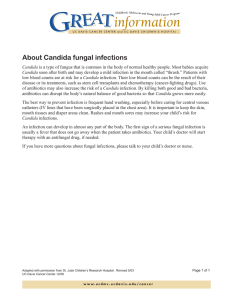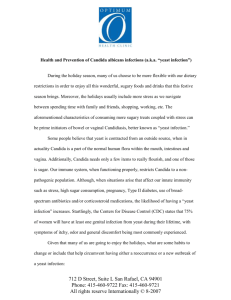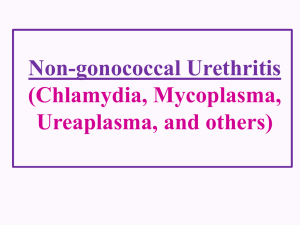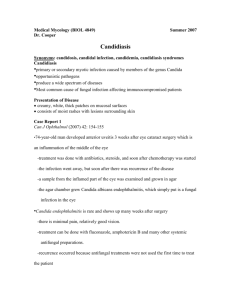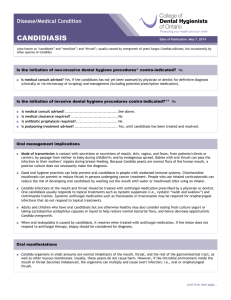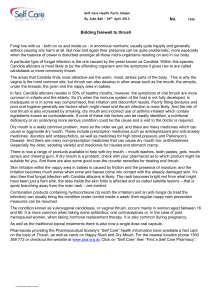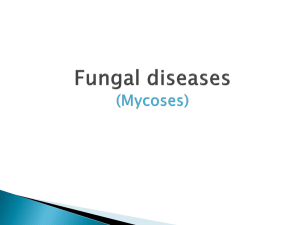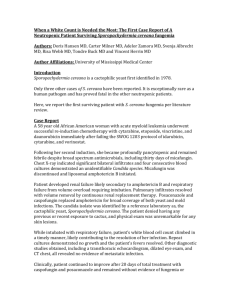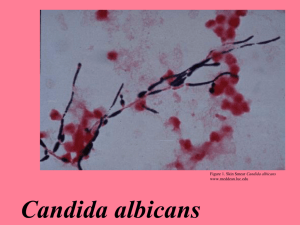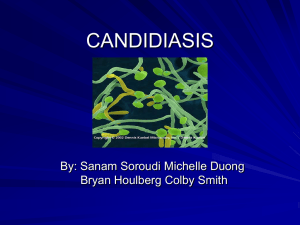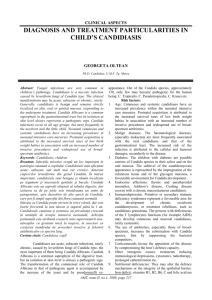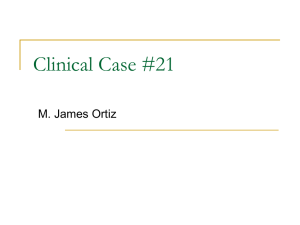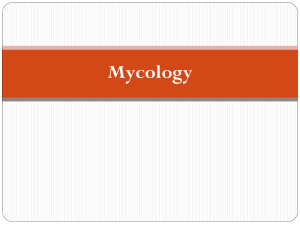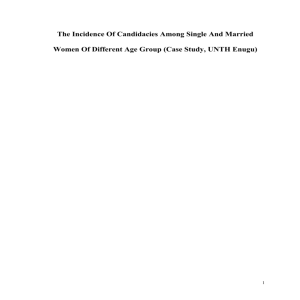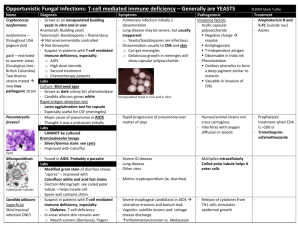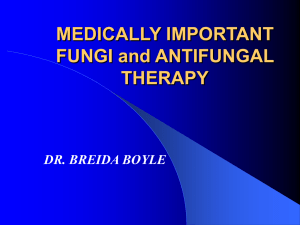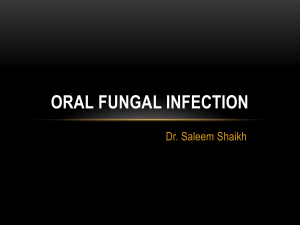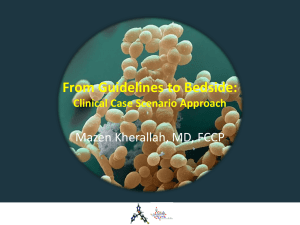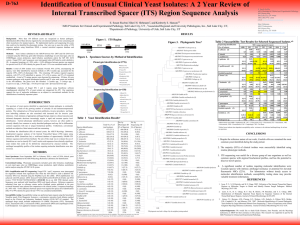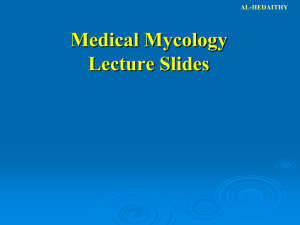501 - The AIDS InfoNet
advertisement
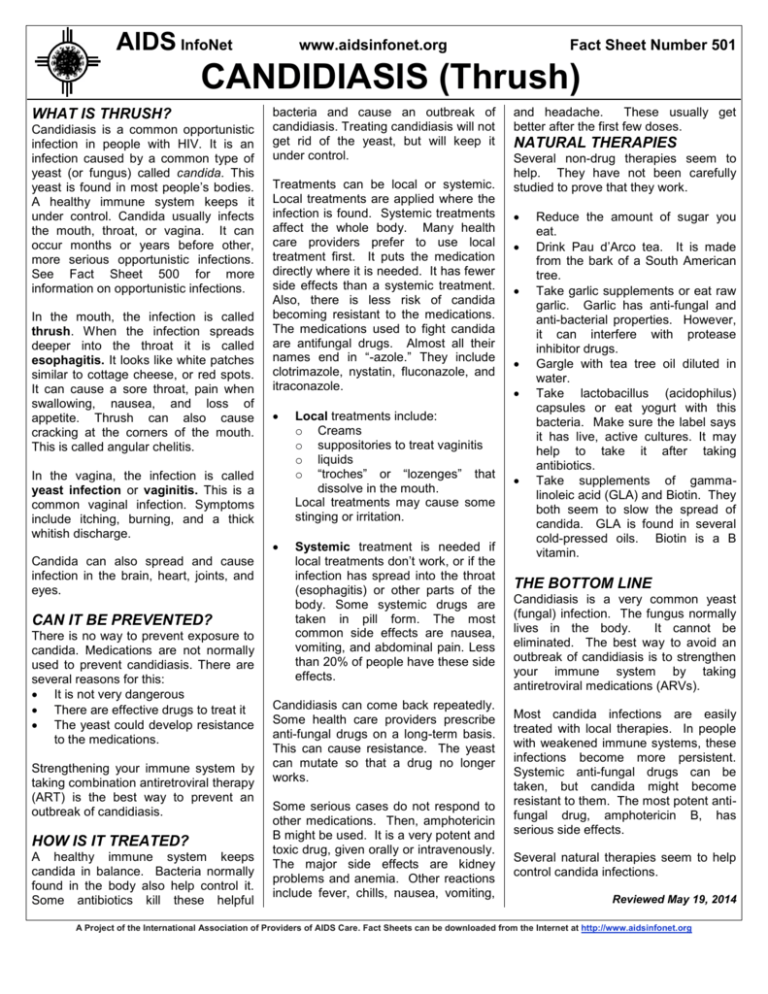
AIDS InfoNet www.aidsinfonet.org Fact Sheet Number 501 CANDIDIASIS (Thrush) WHAT IS THRUSH? Candidiasis is a common opportunistic infection in people with HIV. It is an infection caused by a common type of yeast (or fungus) called candida. This yeast is found in most people’s bodies. A healthy immune system keeps it under control. Candida usually infects the mouth, throat, or vagina. It can occur months or years before other, more serious opportunistic infections. See Fact Sheet 500 for more information on opportunistic infections. In the mouth, the infection is called thrush. When the infection spreads deeper into the throat it is called esophagitis. It looks like white patches similar to cottage cheese, or red spots. It can cause a sore throat, pain when swallowing, nausea, and loss of appetite. Thrush can also cause cracking at the corners of the mouth. This is called angular chelitis. In the vagina, the infection is called yeast infection or vaginitis. This is a common vaginal infection. Symptoms include itching, burning, and a thick whitish discharge. Candida can also spread and cause infection in the brain, heart, joints, and eyes. CAN IT BE PREVENTED? There is no way to prevent exposure to candida. Medications are not normally used to prevent candidiasis. There are several reasons for this: It is not very dangerous There are effective drugs to treat it The yeast could develop resistance to the medications. Strengthening your immune system by taking combination antiretroviral therapy (ART) is the best way to prevent an outbreak of candidiasis. HOW IS IT TREATED? A healthy immune system keeps candida in balance. Bacteria normally found in the body also help control it. Some antibiotics kill these helpful bacteria and cause an outbreak of candidiasis. Treating candidiasis will not get rid of the yeast, but will keep it under control. Treatments can be local or systemic. Local treatments are applied where the infection is found. Systemic treatments affect the whole body. Many health care providers prefer to use local treatment first. It puts the medication directly where it is needed. It has fewer side effects than a systemic treatment. Also, there is less risk of candida becoming resistant to the medications. The medications used to fight candida are antifungal drugs. Almost all their names end in “-azole.” They include clotrimazole, nystatin, fluconazole, and itraconazole. Local treatments include: o Creams o suppositories to treat vaginitis o liquids o “troches” or “lozenges” that dissolve in the mouth. Local treatments may cause some stinging or irritation. Systemic treatment is needed if local treatments don’t work, or if the infection has spread into the throat (esophagitis) or other parts of the body. Some systemic drugs are taken in pill form. The most common side effects are nausea, vomiting, and abdominal pain. Less than 20% of people have these side effects. Candidiasis can come back repeatedly. Some health care providers prescribe anti-fungal drugs on a long-term basis. This can cause resistance. The yeast can mutate so that a drug no longer works. Some serious cases do not respond to other medications. Then, amphotericin B might be used. It is a very potent and toxic drug, given orally or intravenously. The major side effects are kidney problems and anemia. Other reactions include fever, chills, nausea, vomiting, and headache. These usually get better after the first few doses. NATURAL THERAPIES Several non-drug therapies seem to help. They have not been carefully studied to prove that they work. Reduce the amount of sugar you eat. Drink Pau d’Arco tea. It is made from the bark of a South American tree. Take garlic supplements or eat raw garlic. Garlic has anti-fungal and anti-bacterial properties. However, it can interfere with protease inhibitor drugs. Gargle with tea tree oil diluted in water. Take lactobacillus (acidophilus) capsules or eat yogurt with this bacteria. Make sure the label says it has live, active cultures. It may help to take it after taking antibiotics. Take supplements of gammalinoleic acid (GLA) and Biotin. They both seem to slow the spread of candida. GLA is found in several cold-pressed oils. Biotin is a B vitamin. THE BOTTOM LINE Candidiasis is a very common yeast (fungal) infection. The fungus normally lives in the body. It cannot be eliminated. The best way to avoid an outbreak of candidiasis is to strengthen your immune system by taking antiretroviral medications (ARVs). Most candida infections are easily treated with local therapies. In people with weakened immune systems, these infections become more persistent. Systemic anti-fungal drugs can be taken, but candida might become resistant to them. The most potent antifungal drug, amphotericin B, has serious side effects. Several natural therapies seem to help control candida infections. Reviewed May 19, 2014 A Project of the International Association of Providers of AIDS Care. Fact Sheets can be downloaded from the Internet at http://www.aidsinfonet.org

